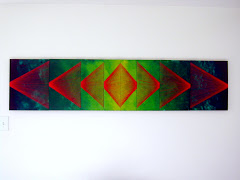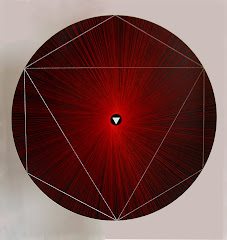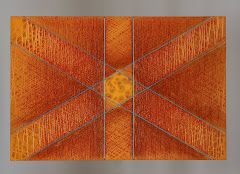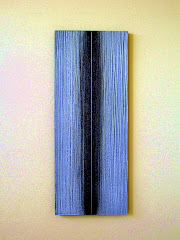Monday, November 11, 2013
My Significant Other is the Kosmos Redux: Part 5 - Prelude and Fugue #2
Prelude
I was listening to an audio tape by the spiritual teacher Adyashanti and heard an interesting description of a method he used which he characterized as an inquiry. Apparently when he was a young man and in the early stages of his path he would go to a coffee shop after work and, while nursing a cup of Joe, write in a notebook in an attempt to answer a deep question such as "What is surrender?". He would continue to write until he approached the very border of what he knew to be true, teasing out everything he had in him, then stop and wait. He would not write another word until a real truth came to him - no theorizing, no fantasy, no wishful thinking. Oftentimes he would wait for hours for the next truth to appear, but always he held back until he knew that what was to be written was indeed true.
Upon hearing this I realized that he was essentially describing my own method in writing this blog. This is really an inquiry into the questions I find myself asking, and in that regard also an articulation both for myself and you the reader, one that is intended as a dialogue even if I can't hear your internal mutterings in response. And as far-fetched as some of it may seem, everything I write is the truth from my experience (or in some cases, a tentative speculation based on true experience - this is, after all, an inquiry). Of course, I may be fooling myself, but then part of the nature of an inquiry is to unmask self-deception, and part of the nature of a dialogue is to corroborate and articulate experience. Webs of Interlocution, my friend!
The point of this is, I have been told by a few that I'm a tease, leaving the reader hanging on the end of a limb with each new posting. And sometimes that hang-time is really, really long. My advice is that, like a football player returning a punt, you call fair catch and wait for the ball to nestle into your waiting arms, and be assured that as I end each posting I've taken it to the very border of what I know and no further, except maybe to peak over the edge into the unknown. Besides, after a fair catch the clock stops until the next play begins, so rest in timelessness! And as always, to be continued...
Fugue
There is apparently a branch of scientific speculation known as Neuroaesthetics, the study of the neurological correlates to aesthetic appreciation - or as one article about this was titled, "Beauty is in the Brain of the Beholder". It seems that some neuroscientists have discovered areas of the brain that are activated by aesthetic beauty, and have even been able to increase appreciation of beauty in some cases by stimulating that area. This has led to speculation about the purpose of art for humans, especially interesting as art appears to be ubiquitous in human culture. In fact, many anthropologists point to the first appearance of art in the form of cave paintings and adornment-making all over the planet as a marker of the dawn of humanity around 50,000 years ago. So the question that naturally arises is, "Why art?".
Indeed, I've been asking myself that question for quite awhile. This new neurological exploration hints at some tantalizing clues, mostly based on evolutionary survival advantage - for instance, one theorist speculating that Cro-Magnon man survived while our Neanderthal cousins became extinct because of the introduction of art in our ancestors as a method of imaginative problem-solving (and I might add, imaginative web-of-interlocution building). This is all fascinating, and certainly a piece of the puzzle. However, reducing everything to biological survival advantage, as fashionable as it is these days, hardly answers the really, really big questions. If we're to seriously ask "What are we, why are we here, what are we doing here", and now add to this "Why art?", can the answer really be..... simply to better survive and propagate? After all, that answer begs the question, "Why survive?", a question that appears to be utterly ignored in scientific discourse.
Methinks we gotta dig deeper, spin finer webs, cast them far and wide. Because the truth of "Why art?" can't be captured in the puny net of "biological survival and propagation of the species". And I suspect the truth of "Why Art" is intimately connected to the truth of "What are we, why are we here, what are we doing here?". So let the inquiry begin!
Let's begin back in the day, those good old days when art first emerged in human culture. 50,000 years or 100,000 years, it matters not. Whether by UFO visitation, space wandering mushroom spores, natural selection, or grace, it matters not. What does matter is that suddenly something new emerged, something apparently in the consciousness of those proto-humans that hadn't existed anywhere on the planet for billions of years. It's interesting to look at these early humans because they were presumably free of so many of our modern affectations - narcissistic self-expression, hunger for fame, commodity market manipulation, to name a few. They were big apes on the savannah, mostly interested in the next meal and a little nookie, and suddenly they started making stuff that seemingly had more to it then just survival and sex (though admittedly some anthropologists still insist on reducing all early human motivation, including art, to the next meal and a little nookie).
There's a possible clue in the famous cave paintings at Lascaux, France. This site is not the oldest evidence of art making by humans, dated to about 17,000 years ago, but is certainly a production of pre-civilized humanity, long before Stonehenge, long before the Pyramids. The huge caves are filled with hundreds of images of animals, a shaman-like man, apparent star charts, and abstract symbols. An interesting aspect of the caves is the manner in which they were discovered - a teenager in France in 1940, while searching for treasure, happened upon a narrow channel in the ground and explored it with three friends, crawling on their bellies in the dark for many yards and coming upon the vast caves in total darkness. When they lit an oil lamp they were probably the first humans in many, many thousands of years to lay eyes on this astonishing gallery of images.
Now, imagine yourself as a Stone Age individual being led for the first time to the caves. Under a cloak of mystery you're pushed into a narrow, completely dark channel in the ground, urged on to crawl an unknown distance in total sensory deprivation (accept for hard earth under your hands and knees and the occasional invisible crawly thing on your skin). Finally, after a seemingly endless and terrifying journey, you come out into a large chamber and stand as someone lights a torch, revealing hundreds of ghostly animals and symbols dancing all about you in the flickering light of the torch, eerily alive yet just as eerily unreal Is it too much to speculate that your breath would be taken away, that you would have an experience far removed from a good steak and a great lay, that you just might be blown right out of yourself and into a truly transformative experience?
That's what I call one powerful web of interlocution! And if I'm right, it would have been building completely new, completely evolutionary structures in the consciousness of those early humans, structures that may well have benefited survival but most certainly had deeper implications.
To be continued...
Subscribe to:
Post Comments (Atom)





.jpg)
No comments:
Post a Comment